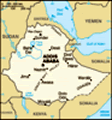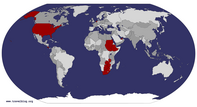Advertisement
Published: June 24th 2009
Where do I begin? There is so much to tell; I don’t know where to start. We arrived in Bahir Dar and almost immediately went to Feledge Hiwot Regional Hospital where the CEO of the hospital along with a doctor from Spain who is working on the sewage project and my friend Charlie who is assigned here from the Clinton Foundation met us with open arms. Nolawi, my filmmaker with camera in tow was well prepared to film the conditions of the hospital. He is Ethiopian and he has said he knows how poor his country is and wants to help in anyway. So after a relaxing Ambo (mineral water) under a large 100-year-old shade tree, our 3 and half hour tour began. Words and even pictures and even video can not describe what we saw. My comment to our host and the doctors that joined our tour was, I don’t think even video can capture the need here. I don’t think my words will ever be enough to convey the feeling this place brings up in you inside. I will never be able to convey the smells and sounds that add texture to the photo’s I took. Before I will

 Mom and Child
Mom and Child
This baby suffers from malnutrition. even try to tell the tale I will tell what Nolawi said. At one point I looked over at him and he looked sick, not as in physical but as in overwhelmed and burdened. He said to me with a broken voice, I have never seen anything like this. I am mad, sad overwhelmed and disgusted. That is what I felt the very first time I visited there and I explained to him those are the feelings that has driven my mission in the last few years.
This visit was unprecedented. All the officials knew I was coming and cleared their calendars for me. Meeting with the Health Bureau Chief in Addis also added more weight to my visit as well. We had video and camera access to every part of the hospital. We were shown every room every department, every broken sink and tub and much more important the faces of the patients and their families. There were things that had changed for the better since my last visit, like there were 2 new buildings on the compound to be for private pay patients, to generate more income for the hospital of those who can pay. There was
more organization this time where hundreds of people were not just walking around in chaos like there were before, waiting to be seen in clinic or in the hospital. They had built a waiting area where people would sit and wait until their number was called. The paths between each building in the compounds were paved with stones unlike the mud that was there before which was everywhere on the floors then. There also is construction of sewage systems designed and paid for by the Spanish government with a consultant on site to manage the project. So these were very big improvements, I could see first hand from my last visit. But the honestly, having this long tour of the facility showed me more needed then ever before. I too was overwhelmed and wondered how we can move this facility forward.
I took hundreds of pictures and some I refused to take because showing the suffering of children and people moaning in pain serves no purpose. For those people I touched their hands rub their cheeks but did not put a camera in there face.. Despite the language barrier I was able to communicate my concern to them with
simple gestures and they were able to back to me. The patients I did take pictures of were happy to most times because I would show them their image, which always brings a smile to their face. They would all gather and want me to take picture after picture so I could show them their selves. It was an exciting thing to most of them. The children particularly loved in and would gather more children so I could get group shots and laughed with joy when they saw each other through the tiny screen on my camera.
The conditions of the hospital at best could be described as unimaginable. As westerners, we could not in our wildest inventive mind picture being sick and helpless in a health care facility with the lack of resources. I have talked about the lack of running water for years in the hospital. That situation is one that still boggles my mind as to how you have health facility with no water inside it. Sinks and tubs that have sat dry for countless years are use to collect things instead of water. It really is amazing how this problem is one that is just

 The Orphan
The Orphan
This child is diabetic and deaf and has no parents. She had little chance if someone doesn't take her in and help her manage her diabetes.accepted as the way it is.
There were other things at this facility that were equally as troubling. The facts are there is extreme shortage of working medical equipment. There is only one working X-ray machine that is 30 years old in the entire hospital. A mobile one is was donated from the west but it was never functional. Many times western hospitals send their outdated and broken medical equipment over to Africa as tax write off but the equipment is never usable and litters the hospital. Outside operating room were two huge surgical tables that had just arrived from the west both broken down and never operational. The people who had this shipped off knew that they were unloading their junk on Africa. There are many cases of where things are sent and nobody has the technical skills to use, so they sit store away. Working usable equipment is a huge issue here in Africa.
As we toured the hospital, certain things are so apparent. With the lack of proper cleaning resources, infection control is little at best. We walked into a children’s ward where there was a small girl about the age of 7 or 8
who was 80% burned over her body sharing a room with 5 or 6 other children plus all the family members of each patient that are there around the clock. A burn patient is one wound completely open so the infection can set in very easily. It looked like the only parts of her body that were not burn were her ankles and her feet and her neck and face. The rest of her skin was gone. There she was lying in pain for the last month with just a cloth covering her bed. To be honest it was amazing she was alive but with the exposures in the room, her outcome is questionable. This broke my heart. She looked at me with desperate eyes, wanting help as she had a low constant moan of pain. I asked if she could get some more pain medicine and the Mother look so thankful, I had spoken up in her behalf.
The problem with no running water and the numbers of people in the hospital makes it very dirty. It is a very large place that would seem overwhelming to clean when bucket after bucket would have to be brought in
from the outside. So I understand why it is the way it is but it has to change. Infections from being in the hospital are very common. This is a hard fact to admit of the officials there but this is fact. Infection control has to be a bigger priorty.
The lack of doctors is a huge problem as well. I talked at length to one of the doctors that explained since there is no orthopedist on staff at all, many broken bones are handle in an extreme way. An example, is when a femur bone in the upper thigh is broken an orthopedist could normally set the bone and cased it. Since there is no specialist here at this hospital the patient must lay in traction for at least 12 weeks in the hospital. They use grocery bags with dirt or sand in them to weigh down the leg. It is a long painful process and I was shocked as went into room after room how many patients on traction there were. This is just one example of the shortage of doctors and the affects it has on their patients. There are more Ethiopian doctors in Chicago then

 Eye Infection
Eye Infection
Eye Infections are very common in Africa. Most times they get so bad patients have to be hospitalized. This boy will lose part of his sight in that eye.in all of the Ethiopia.
I could start listing the all the ailments patients come to the hospital but the one that was most surprising to me was diabetes. Both type 1 and type 2 diabetes is on the rise here in Ethiopia and there really is not concrete explanation. The one of the biggest problems is many times people come in near fatal states, since they did not know they were diabetic and sometime lose vision, feet, legs and all the goes along with untreated diabetes. Insulin injection is the treatment for this but the biggest problem with that is, insulin must be kept cold and if you are in the rural areas or even poor within the city, you can’t keep your medication cold. They are told to put it in a stone case and buried it in the ground, which is the best alternative to someone with no access to refrigeration. I saw many young patients who have to be admitted to the hospital to get their condition under control and taught how to inject their selves with insulin. It is a very difficult prognosis here, because the unknown is whether they will be able

 Squat toliet
Squat toliet
These are common in Africa and the middle east. This is one that functions and is considered a good toilet.to maintain their medicine to stay healthy.
This is about 1/4 of what I learned on my few days at that hospital but clearly a lot is desperately needed here and the other hospitals in this region. This will take many people to put their heads together to solve these problems but nothing is insurmountable.
I am going to stop here writing and post some pictures a few might be distrubing but it is truth. This is way I came and why I need all the help, money and support I can get to help these people have the care they deserve.
It just will take time, patience, money and love.
Advertisement
Tot: 0.09s; Tpl: 0.017s; cc: 10; qc: 51; dbt: 0.0593s; 1; m:domysql w:travelblog (10.17.0.13); sld: 1;
; mem: 1.2mb























anonymous
non-member comment
Very moving
Hi Kim, your blog is so touching and heatbreaking. Please keep us posted on what happens with Mamar. Also let us know if there is anything we can do to help this girl. Thank you for the work you are doing.